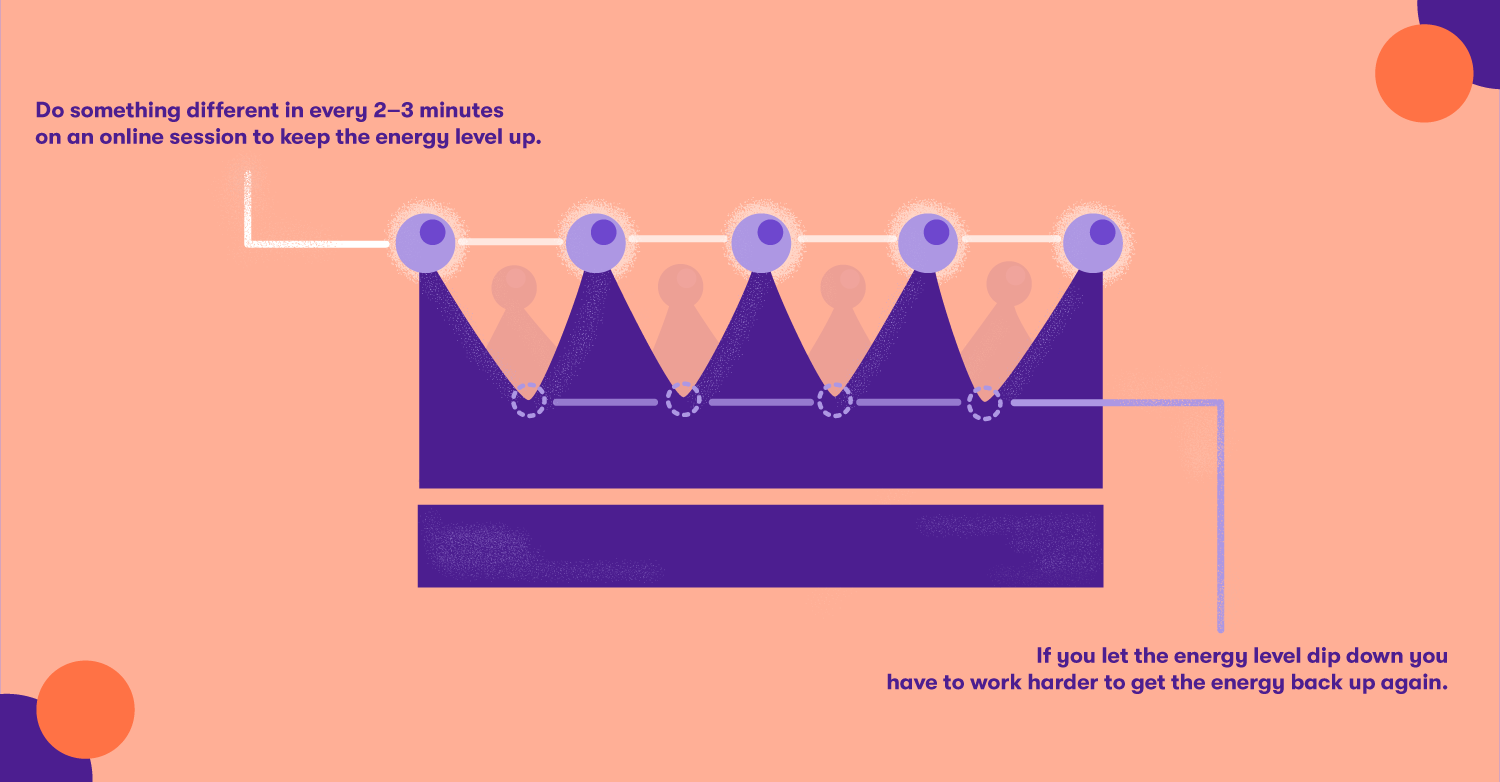
5 Tips on How to Make Your Virtual Training More Engaging
If you feel virtual training is difficult to make engaging for your participants, you are not alone. Especially for those who are more accustomed to face-to-face learning, navigating the digital environment can feel daunting at first.
Few things are more disheartening than realizing that the program, course, or session you have been working so hard to design and deliver is not gaining the traction it deserves. It can be a discouraging experience to see your participants becoming disengaged and zoning out.
But this should not make you think that digital learning is in any way inferior to face-to-face learning – quite the opposite! It has its unique advantages, which we will discuss more below.
In this article, we have collected our top five tips on how to make virtual training more engaging:
- Design an engaging virtual training journey
- Regularly shift the energy during the training
- Engage your participants in talking and writing
- Add creativity to your training delivery
- Make learning happen on the job
We hope they will be useful to anyone who would like to improve participant engagement and stickiness for their virtual learning program, course, or session.
1. Design an engaging virtual training journey
Everything starts from the design, of course. The major difference between all remote learning and development, as opposed to face-to-face learning and development, is that the former requires a more robust split into synchronous and asynchronous activities. What this means in practice is that the synchronous – or live – training session should not last too long – concentrating on something for hours on end is hard.
Because there is less peer pressure to participate in a remote environment, it is also important to make the entire learning journey and your expectations very clear to the participants up front. Everyone needs to be aware of what to expect at what stages and why they should invest their time and energy into the training. It is easier to stay engaged when you know what you will get out of the training.
And, of course, a single learning program should be part of a larger training plan or strategy, so helping participants make sense of how their training fits in the larger picture is vital as well.
2. Regularly shift the energy of your virtual training
Marnie Smith, the Managing Partner at Lighthouse NINE Group, frequently uses Howspace in her work. Lighthouse NINE is a business management consulting firm focusing on improving organizational performance through people. Smith is well-versed in the challenges of how to keep virtual training sessions engaging.
According to her, the facilitator should ‘shift the energy’ of a virtual training session every 3 to 5 minutes because that is about as long as people can focus without interruption.
‘You shift energy by putting your participants into breakout rooms, by asking them to complete an activity, by changing who is speaking, or by asking a question.”
Marnie Smith visualizes this process into a shape that looks like the top of a crown: as long as there is a shift in energy at regular intervals, participant concentration does not fall, and therefore people stay engaged.
‘You want to keep the energy at the peaks of the crown versus letting it dip down because then you will have to work so hard to get the energy back up,’ she describes.

Psst! If you’d like to experience how a simple platform can help you make virtual training more engaging and inclusive, you can start for free today.
3. Engage your participants in talking and writing
Edgar Dale’s ‘Cone of Experience’ from the 1960s is still relevant. Dale theorized that learners retain more information by what they do and speak of as opposed to what they read, hear or observe.
What this primarily means in the context of how to make virtual training session more engaging: you need to look at all these many layers of learning and emphasize the active learning element, where your participants will do something with the information you are sharing.
This is where the power of digital learning can be fully realized. You can ask all of your participants to provide input, and even if there were many of them, you could still process it in a meaningful way and get everyone’s voice heard. In practice, this would mean leveraging features such as polling or voting or analysing input with an AI that can categorize and summarize responses.
From a learning perspective, this creates a powerful feedback loop: many people are hesitant to provide input in a face-to-face setting but will participate in a digital and possibly anonymized context. This way, they experience – possibly for the first time – that their input and ideas are being implemented. This is how they stay engaged in the virtual learning journey, and this is how it becomes effective.
4. Add creativity to your virtual learning delivery
Taking the previous tip 3 even further, not only does talking and writing enhance learning but creating something does.
This could mean a variety of things depending on what kind of virtual training you are facilitating and for what kind of group.
For example, you could reserve a moment within your workshop and ask your participants to search for images that are related to the topic you are exploring and compile a collage of them. This enhances their learning as they deploy creativity and offers them a powerful visual cue to refer back to.
Similarly, activities such as ice-breakers and games allow people to be creative in the way they act, which does tend to create memories that stick.
You should also consider borrowing methods of engagement from social media. For example, you could ask your participants to record a short introduction video of themselves before the start of the learning program. This allows them to share their expectations of the program with each other as well as to get to know each other. Similarly, as part of the ongoing learning process, you could ask your participants to share a video on how they have applied their learning in their daily life.
5. Make the learning happen on the job
According to research, a staggering 70% of learning happens during daily work, not in sessions or classrooms. This is why it is absolutely crucial to make sure that the asynchronous part of your learning program is integrated into the daily work and life of your participants. The more they are able to connect their work with the learning program, the better. This is particularly important for the work in between the learning sessions and after the process: only when your participants continue applying their learnings in practice over a period of time, only then the learning can stick. Digital tools are helpful in making this happen – for example, you can send your participants reminders, questions and other messages to activate and re-engage them.
Final note: Keep tools simple
For organizations, virtual learning is no doubt the superior choice: not only is it less costly but also, on average, more effective. This is due to the collaborative dimensions of virtual learning, as discussed above.
But, as this article remarks, delivering engaging and sticky virtual learning session does require a skill. Besides the tips above, choosing the right digital facilitation tools is also important.
In short, one should employ all the tools they need but be careful not to make the digital environment too scattered or complicated. For example, Howspace and a video conferencing tool such as Zoom are enough to cater for all virtual training needs. Then you will just need your program and your enthusiastic participants – and you are good to go!
Want to build your own workspace to create a sprint plan or a learning course? You can sign up now to access Howspace for free!